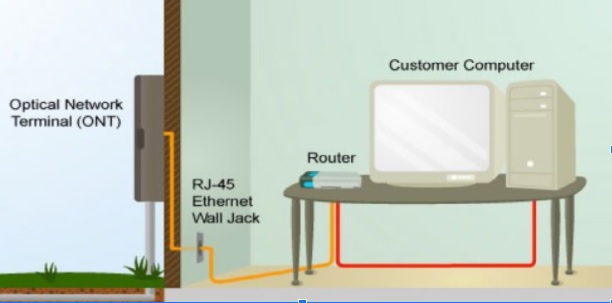How does an ONT work in a fiber optic internet system?
What Is an ONT?
Do you ever think about how your eyes work? It’s an amazing process really: information (in the form of light) enters the eyes, hits the retina, and the retina helps transfer that light into electrical signals the brain can understand and interpret. Well, an optical network terminal (or ONT) has a similar function to the retina—it converts fiber signals (light, basically) into digestible information your devices can understand.
If you have a fiber internet connection, an ONT serves as an integral part of your system. Without it, your devices wouldn’t know what to do with the incoming signal. Think of an ONT as a modem for your fiber optic internet.
Fiber vs. cable internet: What's the difference?
Traditional cable internet uses coaxial cables to send electrical data signals to your cable modem, which in turn connects to your router. Your router then sends a Wi-Fi signal throughout your home. In some cases, homes with cable internet have combination modem-routers (or gateways) that serve both functions.
But it’s becoming increasingly common for people to purchase aftermarket routers in an effort to try and boost their Wi-Fi coverage or to take advantage of additional features like enhanced parental controls, mesh networking, enhanced security, and guest network access.
Fiber internet uses fiber-optic cables instead of coax cables, and these fiber cables are made of thin plastic or glass filaments that can transfer digital data in the form of light. Fiber-optic cables are much more efficient at sending data over long distances, simply because that data is moving as light pulses instead of as electrical signals that are subject to signal interference and distortion. Fiber networks are not only faster, they can also provide symmetrical speeds (the same upload and download speeds) for those who create content or conduct business from home.
So, fiber cables have a faster signal, great. But regardless of how fast that data moves, it’s useless if your devices can’t interpret the signal. This is where an ONT comes into play.

Image credit: Centurylink
The role of an ONT
Where is an ONT usually installed?
There are different models of ONTs, but they all serve the same basic function. CenturyLink, for instance, uses Adtran and Calix-branded ONTs. When installing an ONT device, it usually needs to be plugged into a Ground Fault Circuit Interrupter (or GFCI) electrical outlet (those outlets with the test and reset buttons). The technician can also install a device called a “wall wart,” which CenturyLink says can help prevent damage to the unit from power surges. The ONT may also have a battery backup in the event of power failure, especially if you also have phone-voice service as well through a service like Verizon (so you can still make emergency calls).
Some ONTs are relatively small (not much bigger than a cable modem), while others are rather large. Either way, most ONTs are not the most attractive devices, so they’re usually installed in garages, basements, closets, or other inconspicuous areas. In some cases, a provider may install an ONT outside of a home, but the installation technician will determine the best location based on the specific model, your specific fiber services, your home’s configuration, and other factors.
My ONT is not working—what should I do?
There are a few basic troubleshooting steps you can try if you’re experiencing issues with your ONT unit. If your Verizon Fios ONT device is beeping, it’s likely an issue with your battery backup. You can try disconnecting and reconnecting the battery, but you may need a replacement battery backup. You can usually find a replacement for around $20 on Amazon to $25. Verizon also sells replacements for $40.
If you’re experiencing connection problems, check the indicator lights on your router to make sure they’re all properly lit. If everything looks correct, try rebooting your ONT. You can even try using an Ethernet cable to connect a computer directly to the Ethernet Port on your ONT device (the port’s name will be something like internet or WAN, but this will vary depending on the specific ONT device). This will help determine whether the issue is with your home network or with the ONT (or perhaps the fiber connection coming to your home).
If all of this doesn’t get your system back up and running, you’ll likely have to contact your provider for additional troubleshooting tips.
Still looking? Check out the top ranked fiber providers.
Related Articles



